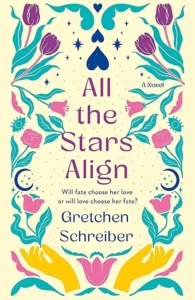All the Stars Align
Gretchen Schreiber
Wednesday Books
Published April 1, 2025
Amazon | Bookshop | Goodreads
About All the Stars Align
All the Stars Align is the magical love story that is Taylor Swift’s Enchanted meets Cyrano, from the author of Ellie Haycock is Totally Normal.
All the women in Piper’s family know their true love at first sight, complete with butterflies, heart eyes, and a gut instinct. The kind of fated love that lasts forever. Piper grew up with her ancestors’ epic love stories repeated like fairy tales, and yearns for the day she’ll start her own. Already singled out in her family due to her physical disability, Piper collects a second strike against her when her parents announce their divorce, which convinces her family that she’s doomed.
When she finally finds her true love at a party, she’s more determined than ever to attain her love story and earn a spot in her family. But after completely botching their first meeting, she realizes that she’ll need help from her best friend Leo, who is sort of a love expert. The catch—he and Piper haven’t talked in six months, since he needed a “break” from their friendship.
To win over the love of her life and a place in her family, Piper must convince Leo to teach her his ways. And it’s all going as planned…until Leo confesses his own love for Piper. Now, she must decide which fate to follow.
My Review
This book started a little slowly for me. It’s pretty clear from the beginning that Leo has feelings for Piper, and she’s too deliberately oblivious to see it. Just as he’s about to confess how he feels, she meets the person she’s been waiting for: a boy named Forest, whose presence makes her feel a tug in her heart.
The biggest thing that elevates what would be a simple love story is the subplot about Piper’s parents, who, despite the family Blessing identifying them as true loves, have recently divorced. At first, Piper is committed to her aunts’ campaign to reunite her parents. After all, it’s clear the two still love each other.
As Piper explores her feelings for Leo and Forest, she begins to question whether letting Fate choose her romantic destiny is the right choice. Is it what she truly wants, or is it a safe way to ensure her place in her larger family?
Piper has some physical disabilities, including scoliosis. Her feelings about being a disabled child and possible love interest also come into play as she explores her family relationships and romance.
Diana, Piper’s best friend, is easily my favorite character. I liked the way that she navigated the mess between Piper and Leo and adored that she had her own unexpected love story in the mix as well.
If you liked The Charmed List by Julie Abe, then definitely check out The Stars Align.
Content Notes
Recommended for Ages 14 up.
Profanity/Crude Language Content
Strong profanity used periodically.
Romance/Sexual Content
Kissing.
Spiritual Content
Some people believe in the goddess Fate, Piper’s family among them. Members of Piper’s family have been gifted a Blessing that allows them to know their true love when they meet them.
Violent Content
None.
Drug Content
Teens drink alcohol at a party.
Note: This post contains affiliate links, which do not cost you anything to use but help support this blog. I received a free copy of this book in exchange for my honest review. All opinions are my own.
